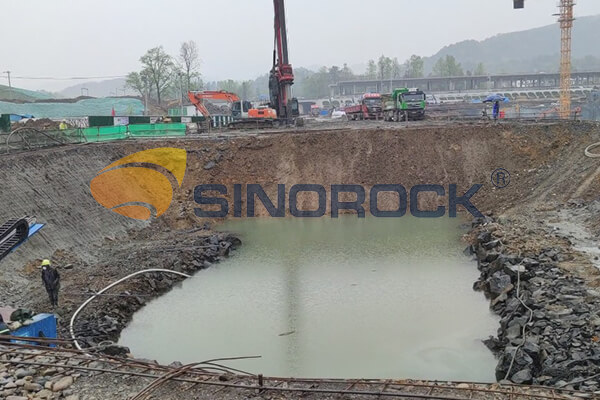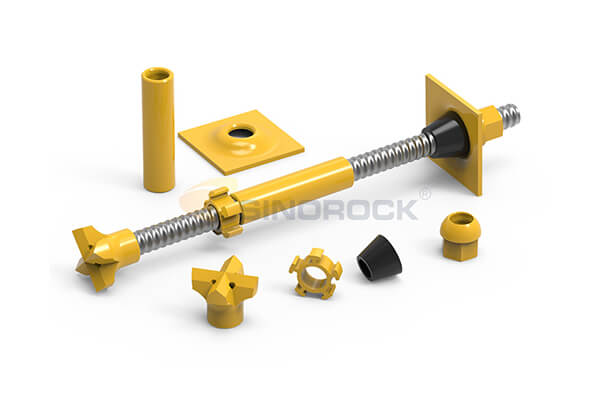Application of Self-drilling Rock Bolt in Loose Soil Foundation Support
Time:2022-08-08From:sinorock View:
The self-drilling rock bolt realizes the integration of three functions of drilling, grouting, and anchoring, and can be constructed safely and efficiently under complex geological conditions. Today, Sinorock will take you to understand the application of self-drilling rock bolts in foundation pit support in loose soil layers.
The stratum where the foundation pit is located from top to bottom is mixed fill, silty clay, silt soil, and loose soil layers such as fine-medium sand, pebbles, and fine-medium sand, as well as groundwater, and the engineering geology is complicated. Under this geological condition, it is extremely difficult to form pores by traditional techniques. After changing to the self-drilling rock bolt, the shortcomings of ordinary anchors such as hole collapsing, stuck drills, and inability to insert into the rod body are avoided.
.jpg)
Features and Principles of Self-Drilling Rock Bolts
The drill pipe is the anchor rod body, and the two are integrated. It does not need to exit after drilling in low-strength and loose formations, and the hollow rod body can be used for grouting. The grouting process while drilling can improve the grouting effect. The rod with full-length standard thread can facilitate the installation of the backing plate and the length of the connecting sleeve, so it can construct a long anchor rod with a length of more than 10m in a narrow space. The protective layer.
Construction Technology of Self-Drilling Rock Bolt
The quality of the self-drilling hollow bolt directly affects the bearing capacity of the bolt. The construction process of the anchor rod is as follows.
Construction Preparation - Anchor Rod Production - Drilling and Grouting - Installation of Plates and Nuts.

Construction Preparation
The anchor rod is a tension member buried in the stratum. It is a hidden project. The construction preparation work should be carried out in multiple directions and be as detailed as possible, including:
Fully understand the surrounding conditions of the anchoring project, grasp the influence of various surrounding buildings and strata properties on the anchoring construction, and determine the countermeasures;
The condition of buried objects and obstacles;
The state and water quality of groundwater, a large amount of water is needed in the grouting process of boreholes, and it is necessary to consider whether groundwater can be used, investigate the influence of groundwater on drilling methods, grouting quantity and slurry concentration, and take corresponding countermeasures;
Prepare reasonable drilling rigs and professional construction operators according to the requirements of the project plan;
Anchor Rod Production
The self-drilling bolt has a continuous international standard thread throughout the body, and there are four standard lengths of 2m, 3m, 4m, and 6m. During construction, it can be cut to the required length according to the needs.
Drilling and Groutingt
The drilling of the bolt hole is the key process of the anchoring project. It is also the main factor affecting the economic effect of the anchoring project. The most effective drilling method must be selected and the designed hole diameter, length, and inclination angle must be met. During the drilling process, always check the alignment of the drilled holes.
The selection of drill bits should be based on different geological conditions. For what kind of geology should use what kind of drill bit, you can refer to my another article Types of Self-Drilling Rock Bolt Drill Bits and Applicable Geological Conditions.

When bolts are installed in sandy soil, the grouting pressure has a great influence on the bearing capacity of the bolts, and the bond strength on the interface between the grouting body and the soil body is usually greater than the shear strength of the soil body. The bearing capacity of the bolt increases with the increase of grouting pressure, but when the grouting pressure exceeds 4MPa, the increase of the bearing capacity of the bolt is very small. The grout is injected under pressure by a grouting pump, and after hardening, a solid anchor will be formed, which will bond the anchor rod to the surrounding stratum, reinforce the surrounding stratum, and improve the bearing capacity of the anchor rod. The water-cement ratio of the cement slurry is required to be 0.4~0.6. The grouting pressure is between 0.5~2MPa.
Install the Backing Plate and Nutst
After the grout is completely solidified, install the backing plate and the nut on the exposed end of the self-drilling bolt.
Conclusion
Self-drilling hollow bolts are used for foundation pit support in soil layers with low strength, loose soil layers and high moisture content, such as silty clay and silt soil, which can reduce the difficulty of construction, shorten the construction period and save costs.
latest news
-

- What Are the Applications of SDA Bolts in Hydropower Stations?
- Time:2025-08-21From:This Site
- Learn how self-drilling anchor bolts enhance slope stability, tunnel support, and dam reinforcement in complex geological conditions at hydropower stations. Optimize hydropower projects with efficient, cost-effective, and eco-friendly solutions.
- View details
-

- Slope Stabilization with SDA Bolts: Benefits & Applications
- Time:2025-08-19From:This Site
- Discover how self-drilling anchor bolts (SDA bolts) provide superior slope stabilization for highways, railways, and tunnels. Learn their key benefits, installation process, and real-world applications in loose or collapsible soils.
- View details
-

- How Self-Drilling Rock Bolts Enhance Tunnel Support in Fractured Rock?
- Time:2025-08-15From:This Site
- Discover how self-drilling rock bolts enhance tunnel support in fractured rock. Learn their benefits, installation steps, and real-world applications for safe, efficient tunneling.
- View details
-

- Sinorock 2025 Quality Month | Strengthening Quality Foundations, Empowering Product Excellence
- Time:2025-08-13From:This Site
- Sinorock’s 2025 Quality Month, themed “Strengthening Quality Foundations, Empowering Product Excellence,” successfully concluded, reinforcing our commitment to superior product quality.
- View details
-

- Sinorock Safety Month 2025 | Everyone Speaks Safety, Everyone Can Respond
- Time:2025-07-03From:This Site
- Sinorock Safety Month 2025, centered on the theme "Everyone Speaks Safety, Everyone Can Respond - Spot Workplace Hazards," has wrapped up successfully!
- View details
-

- Quality Control: the Vital Factor of A SDA Bolt Factory
- Time:2025-01-09From:This Site
- Sinorock’s comprehensive quality control system, from supplier management to outgoing inspections, ensuring the highest standards for self-drilling anchor bolts in construction.
- View details
-

- Sinorock Invites You to Explore Proven Self-Drilling Anchor Bolt Solutions at bauma 2025
- Time:2025-03-07From:This Site
- From April 7–13, 2025, explore Sinorock’s Self-drilling anchor bolt solution at Booth C2.513/4 in Hall C2 of the Messe München Exhibition Center (Munich, Germany).
- View details
-
.jpg)
- SINOROCK to Attend EXPOMINA PERÚ 2024 in Lima, Peru
- Time:2024-08-10From:This Site
- Sinorock to Attend EXPOMINA PERÚ 2024 in Lima, Peru
- View details
-
.jpg)
- SINOROCK to Participate in MINING AND METALS CENTRAL ASIA 2024
- Time:2024-08-08From:This Site
- SINOROCK to Participate in MINING AND METALS CENTRAL ASIA 2024
- View details
 Download
Download 


